Vol 0, Master Table of Contents & Compliance Requirements
Part A
Master Table of Contents
Master TOC for the Bluetooth Specification
Part B
Bluetooth Compliance Requirements
Contents
1 Scope
2 Definitions
3 Legal Aspects
4 Introduction to the Bluetooth Qualification Program
Part C
Appendix
Contents
1 Revision History
1.1 [vol 0] Master TOC & Compliance Requirements
1.1.1 Bluetooth Compliance Requirements
1.2 [Vol 1] Architecture & Terminology Overview
1.3 [Vol 2 & 3] Core System Package
2 Contributors
2.1 [vol 0] Master TOC & Compliance Requirements
2.1.1 Part B: Bluetooth Compliance Requirements
2.2 [vol 1] Architecture &Terminology Overview
2.2.1 Part A: Architectural Overview
2.2.2 Part B: Acronyms & Abbreviations
2.2.3 Part C: Changes from Bluetooth Specification v1.1
2.3 [Vol 2] Core System Package, Controller
2.3.1 Part A: Radio Specification
2.3.2 Part B: Baseband Specification
2.3.3 Part C: Link Manager Protocol
2.3.4 Part D: Error Codes
2.3.5 Part E: Bluetooth Host Controller Interface Functional Specification
2.3.6 Part F: Message Sequence Charts
2.3.7 Part G: Sample Data
2.3.8 Part H: Security Specification
2.4 [Vol 3] Core System Package, Host
2.4.1 Part A: Logical Link Control and Adaptation Protocol Specification
2.4.2 Part B: Service Discovery Protocol (SDP)
2.4.3 Part C Generic Access Profile
2.4.4 Part D: Test Support
Vol 1, Architecture & Terminology Overview
Table of Contents
Part A
Architecture
Contents
1 General Description
1.1 Overview of Operation
1.2 Nomenclature
2 Core System Architecture
2.1 Core Architectural Blocks
2.1.1 Channel manager
2.1.2 L2CAP resource manager
2.1.3 Device manager
2.1.4 Link manager
2.1.5 Baseband resource manager
2.1.6 Link controller
2.1.7 RF
3 Data Transport Architecture
3.1 Core Traffic Bearers
3.1.1 Framed data traffic
3.1.2 Unframed data traffic
3.1.3 Reliability of traffic bearers
3.2 Transport Architecture Entities
3.2.1 Bluetooth generic packet structure
3.3 Physical Channels
3.3.1 Basic piconet channel
3.3.1.1 Overview
3.3.1.2 Characteristics
3.3.1.3 Topology
3.3.1.4 Supported layers
3.3.2 Adapted piconet channel
3.3.2.1 Overview
3.3.3 Inquiry scan channel
3.3.3.1 Overview
3.3.3.2 Characteristics
3.3.3.3 Topology
3.3.3.4 Supported layers
3.3.4 Page scan channel
3.3.4.1 Overview
3.3.4.2 Characteristics
3.3.4.3 Topology
3.3.4.4 Supported layers
3.4 Physical Links
3.4.1 Links supported by the basic and adapted piconet physical channel
3.4.1.1 Active physical link
3.4.1.2 Parked physical link
3.4.2 Links supported by the scanning physical channels
3.5 Logical Links and Logical Transports
3.5.1 Casting
3.5.2 Scheduling and acknowledgement scheme
3.5.3 Class of data
3.5.4 Asynchronous connection-oriented (ACL)
3.5.5 Synchronous connection-oriented (SCO)
3.5.6 Extended synchronous connection-oriented (eSCO)
3.5.7 Active slave broadcast (ASB)
3.5.8 Parked slave broadcast (PSB)
3.5.9 Logical links
3.5.10 ACL Control Logical Link (ACL-C)
3.5.11 User Asynchronous/Isochronous Logical Link (ACL-U)
3.5.12 User Synchronous/Extended Synchronous Logical Links (SCO-S/ eSCO-S)
3.6 L2CAP Channels
4 Communication Topology
4.1 Piconet Topology
4.2 Operational Procedures and Modes
4.2.1 Inquiry (Discovering) Procedure
4.2.2 Paging (Connecting) Procedure
4.2.3 Connected mode
4.2.4 Hold mode
4.2.5 Sniff mode
4.2.6 Parked state
4.2.7 Role switch procedure
Part B
Acronyms & Abbreviations
1 List of Acronyms and Abbreviations
2 Abbreviations of the Specification Names
Part C
Changes from Bluetooth Specification v 1.1
Contents
1 New Features
2 Changes in Wording
2.1 IEEE Language Update
2.1.1 Shall
2.1.2 Must
2.1.3 Will
2.1.4 Should
2.1.5 May
2.1.6 Can
2.2 Nomenclature Changes
3 Structure Changes
4 Deprecated Specifications
4.1 Deprecated Features
4.2 Deprecated Profiles
Vol 2, Core System Package [Controller volume]
Table of Contents
Part A
Radio Specification
Contents
1 Scope
2 Frequency Bands and Channel Arrangement
3 Transmitter Characteristics
3.1 Modulation Characteristics
3.2 Spurious Emissions
3.2.1 In-band spurious emission
3.3 Radio Frequency Tolerance
4 Receiver Characteristics
4.1 Actual Sensitivity Level
4.2 Interference Performance
4.3 Out-of-Band Blocking
4.4 Intermodulation Characteristics
4.5 Maximum Usable Level
4.6 Receiver Signal Strength Indicator
4.7 Reference Signal Definition
5 Appendix A
5.1 Nominal Test Conditions
5.1.1 Nominal temperature
5.1.2 Nominal power source
5.1.2.1 Mains voltage
5.1.2.2 Lead-acid battery power sources used in vehicles
5.1.2.3 Other power sources
5.2 Extreme Test Conditions
5.2.1 Extreme temperatures
5.2.2 Extreme power source voltages
5.2.2.1 Mains voltage
5.2.2.2 Lead-acid battery power source used on vehicles
5.2.2.3 Power sources using other types of batteries
5.2.2.4 Other power sources
6 Appendix B
Part B
Baseband Specification
Contents
1 General Description
1.1 Bluetooth Clock
1.2 Bluetooth Device Addressing
1.2.1 Reserved addresses
1.3 Access Codes
2 Physical Channels
2.1 Physical Channel Definition
2.2 Basic Piconet Physical Channel
2.2.1 Master-slave definition
2.2.2 Hopping characteristics
2.2.3 Time slots
2.2.4 Piconet clocks
2.2.5 Transmit/receive timing
2.2.5.1 Piconet physical channel timing
2.2.5.2 Piconet physical channel re-synchronization
2.3 Adapted Piconet Physical Channel
2.3.1 Hopping characteristics
2.4 Page Scan Physical Channel
2.4.1 Clock estimate for paging
2.4.2 Hopping characteristics
2.4.3 Paging procedure timing
2.4.4 Page response timing
2.5 Inquiry Scan Physical Channel
2.5.1 Clock for inquiry
2.5.2 Hopping characteristics
2.5.3 Inquiry procedure timing
2.5.4 Inquiry response timing
2.6 Hop Selection
2.6.1 General selection scheme
2.6.2 Selection kernel
2.6.2.1 First addition operation
2.6.2.2 XOR operation
2.6.2.3 Permutation operation
2.6.2.4 Second addition operation
2.6.2.5 Register bank
2.6.3 Adapted hop selection kernel
2.6.3.1 Channel re-mapping function
2.6.4 Control word
2.6.4.1 Page scan and inquiry scan hopping sequences
2.6.4.2 Page hopping sequence
2.6.4.3 Slave page response hopping sequence
2.6.4.4 Master page response hopping sequence
2.6.4.5 Inquiry hopping sequence
2.6.4.6 Inquiry response hopping sequence
2.6.4.7 Basic and adapted channel hopping sequence
3 Physical Links
3.1 Link Supervision
4 Logical Transports
4.1 General
4.2 Logical Transport Address (LT_ADDR)
4.3 Synchronous Logical Transports
4.4 Asynchronous Logical Transport
4.5 Transmit/Receive Routines
4.5.1 TX Routine
4.5.1.1 ACL traffic
4.5.1.2 SCO traffic
4.5.1.3 Mixed data/voice traffic
4.5.1.4 eSCO Traffic
4.5.1.5 Default packet types
4.5.2 RX routine
4.5.3 Flow control
4.5.3.1 Destination control
4.5.3.2 Source control
4.6 Active Slave Broadcast Transport
4.7 Parked Slave Broadcast Transport
4.7.1 Parked member address (PM_ADDR)
4.7.2 Access request address (AR_ADDR)
5 Logical Links
5.1 Link Control Logical Link (LC)
5.2 ACL Control Logical Link (ACL-C)
5.3 User Asynchronous/Isochronous Logical Link (ACL-U)
5.3.1 Pausing the ACL-U logical link
5.4 User Synchronous Data Logical Link (SCO-S)
5.5 User Extended Synchronous Data Logical Link (eSCO-S)
5.6 Logical Link Priorities
6 Packets
6.1 General Format
6.2 Bit Ordering
6.3 Access Code
6.3.1 Access code types
6.3.2 Preamble
6.3.3 Sync word
6.3.3.1 Synchronization word definition
6.3.3.2 Pseudo-random noise sequence generation
6.3.4 Trailer
6.4 Packet Header
6.4.1 LT_ADDR
6.4.2 TYPE
6.4.3 FLOW
6.4.4 ARQN
6.4.5 SEQN
6.4.6 HEC
6.5 Packet Types
6.5.1 Common packet types
6.5.1.1 ID packet
6.5.1.2 NULL packet
6.5.1.3 POLL packet
6.5.1.4 FHS packet
6.5.1.5 DM1 packet
6.5.2 SCO packets
6.5.2.1 HV1 packet
6.5.2.2 HV2 packet
6.5.2.3 HV3 packet
6.5.2.4 DV packet
6.5.3 eSCO packets
6.5.3.1 EV3 packet
6.5.3.2 EV4 packet
6.5.3.3 EV5 packet
6.5.4 ACL packets
6.5.4.1 DM1 packet
6.5.4.2 DH1 packet
6.5.4.3 DM3 packet
6.5.4.4 DH3 packet
6.5.4.5 DM5 packet
6.5.4.6 DH5 packet
6.5.4.7 AUX1 packet
6.6 Payload Format
6.6.1 Synchronous data field
6.6.2 Asynchronous data field
6.7 Packet Summary
7 Bitstream Processing
7.1 Error Checking
7.1.1 HEC generation
7.1.2 CRC generation
7.2 Data Whitening
7.3 Error Correction
7.4 FEC Code: Rate 1/3
7.5 FEC Code: Rate 2/3
7.6 ARQ Scheme
7.6.1 Unnumbered ARQ
7.6.2 Retransmit filtering
7.6.2.1 Initialization of SEQN at start of new connection
7.6.2.2 ACL and SCO retransmit filtering
7.6.2.3 eSCO retransmit filtering
7.6.2.4 FHS retransmit filtering
7.6.2.5 Packets without CRC retransmit filtering
7.6.3 Flushing payloads
7.6.4 Multi-slave considerations
7.6.5 Broadcast packets
8 Link Controller Operation
8.1 Overview of States
8.2 Standby State
8.3 Connection Establishment Substates
8.3.1 Page scan substate
8.3.2 Page substate
8.3.3 Page response substates
8.3.3.1 Slave response substate
8.3.3.2 Master response substate
8.4 Device Discovery Substates
8.4.1 Inquiry scan substate
8.4.2 Inquiry substate
8.4.3 Inquiry response substate
8.5 Connection State
8.6 Active Mode
8.6.1 Polling in the active mode
8.6.2 SCO
8.6.3 eSCO
8.6.4 Broadcast scheme
8.6.5 Role switch
8.6.6 Scatternet
8.6.6.1 Inter-piconet communications
8.6.7 Hop sequence switching
8.6.8 Channel classification and channel map selection
8.6.9 Power Management
8.6.9.1 Packet handling
8.6.9.2 Slot occupancy
8.6.9.3 Recommendations for low-power operation
8.7 Sniff Mode
8.7.1 Sniff Transition Mode
8.8 Hold Mode
8.9 Park State
8.9.1 Beacon train
8.9.2 Beacon access window
8.9.3 Parked slave synchronization
8.9.4 Parking
8.9.5 Master-initiated unparking
8.9.6 Slave-initiated unparking
8.9.7 Broadcast scan window
8.9.8 Polling in the park state
9 Audio
9.1 LOG PCM CODEC
9.2 CVSD CODEC
9.3 Error Handling
9.4 General Audio Requirements
9.4.1 Signal levels
9.4.2 CVSD audio quality
10 List of Figures
11 List of Tables
Appendix A: General Audio Recommendations
Appendix B: Timers
Appendix C: Recommendations for AFH Operation in Park, Hold and Sniff
Part C
Link Manager Protocol
Contents
1 Introduction
2 General Rules
2.1 Message Transport
2.2 Synchronization
2.3 Packet Format
2.4 Transactions
2.4.1 LMP Response Timeout
2.5 Error Handling
2.5.1 Transaction collision resolution
2.6 Procedure Rules
2.7 General Response Messages
2.8 LMP Message Constraints
3 Device Features
3.1 General Description
3.2 Feature Definitions
3.3 Feature Mask Definition
3.4 Link Manager Interoperability policy
4 Procedure Rules
4.1 Connection Control
4.1.1 Connection establishment
4.1.2 Detach
4.1.3 Power control
4.1.4 Adaptive frequency hopping
4.1.4.1 Master enables AFH
4.1.4.2 Master disables AFH
4.1.4.3 Master updates AFH
4.1.4.4 AFH operation in park, hold and sniff modes
4.1.5 Channel classification
4.1.5.1 Channel classification reporting enabling and disabling
4.1.6 Link supervision
4.1.7 Channel quality driven data rate change (CQDDR)
4.1.8 Quality of service (QoS)
4.1.8.1 Master notifies slave of the quality of service
4.1.8.2 Device requests new quality of service
4.1.9 Paging scheme parameters
4.1.9.1 Page mode
4.1.9.2 Page scan mode
4.1.10 Control of multi-slot packets
4.2 Security
4.2.1 Authentication
4.2.1.1 Claimant has link key
4.2.1.2 Claimant has no link key
4.2.1.3 Repeated attempts
4.2.2 Pairing
4.2.2.1 Responder accepts pairing
4.2.2.2 Responder has a fixed PIN
4.2.2.3 Responder rejects pairing
4.2.2.4 Creation of the link key
4.2.2.5 Repeated attempts
4.2.3 Change link key
4.2.4 Change current link key type
4.2.4.1 Change to a temporary link key
4.2.4.2 Make the semi-permanent link key the current link key
4.2.5 Encryption
4.2.5.1 Encryption mode
4.2.5.2 Encryption key size
4.2.5.3 Start encryption
4.2.5.4 Stop encryption
4.2.5.5 Change encryption mode, key or random number
4.2.6 Request supported encryption key size
4.3 Informational Requests
4.3.1 Timing accuracy
4.3.2 Clock offset
4.3.3 LMP version
4.3.4 Supported features
4.3.5 Name request
4.4 Role Switch
4.4.1 Slot offset
4.4.2 Role switch
4.5 Modes of Operation
4.5.1 Hold mode
4.5.1.1 Master forces hold mode
4.5.1.2 Slave forces hold mode
4.5.1.3 Master or slave requests hold mode
4.5.2 Park state
4.5.2.1 Master requests slave to enter park state
4.5.2.2 Slave requests to enter park state
4.5.2.3 Master sets up broadcast scan window
4.5.2.4 Master modifies beacon parameters
4.5.2.5 Unparking slaves
4.5.3 Sniff mode
4.5.3.1 Master or slave requests sniff mode
4.5.3.2 Moving a slave from sniff mode to active mode
4.6 Logical Transports
4.6.1 SCO logical transport
4.6.1.1 Master initiates an SCO link
4.6.1.2 Slave initiates an SCO link
4.6.1.3 Master requests change of SCO parameters
4.6.1.4 Slave requests change of SCO parameters
4.6.1.5 Remove an SCO link
4.6.2 eSCO logical transport
4.6.2.1 Master initiates an eSCO link
4.6.2.2 Slave initiates an eSCO link
4.6.2.3 Master or slave requests change of eSCO parameters
4.6.2.4 Remove an eSCO link
4.6.2.5 Rules for the LMP negotiation and renegotiation
4.6.2.6 Negotiation state definitions
4.7 Test Mode
4.7.1 Activation and deactivation of test mode
4.7.2 Control of test mode
4.7.3 Summary of test mode PDUs
5 Summary
5.1 PDU Summary
5.2 Parameter Definitions
5.3 Default Values
6 List of Figures
7 List of Tables
Part D
Error Codes
Contents
1 Overview of Error Codes
1.1 Usage Descriptions
1.2 HCI Command Errors
1.3 List of Error Codes
2 Error Code Descriptions
2.1 Unknown HCI Command (0X01)
2.2 Unknown Connection Identifier (0X02)
2.3 Hardware Failure (0X03)
2.4 Page Timeout (0X04)
2.5 Authentication Failure (0X05)
2.6 PIN Missing (0X06)
2.7 Memory Capacity Exceeded (0X07)
2.8 Connection Timeout (0X08)
2.9 Connection Limit Exceeded (0X09)
2.10 Synchronous Connection Limit to a Device Exceeded (0X0A)
2.11 ACL Connection Already Exists (0X0B)
2.12 Command Disallowed (0X0C)
2.13 Connection Rejected due to Limited Resources (0X0D)
2.14 Connection Rejected due to Security Reasons (0X0E)
2.15 Connection Rejected due to Unacceptable BD_ADDR (0X0F)
2.16 Connection Accept Timeout Exceeded (0X10)
2.17 Unsupported Feature or Parameter Value (0X11)
2.18 Invalid HCI Command Parameters (0X12)
2.19 Remote User Terminated Connection (0X13)
2.20 Remote Device Terminated Connection due to Low Resources (0X14)
2.21 Remote Device Terminated Connection due to Power Off (0X15)
2.22 Connection Terminated by Local Host (0X16)
2.23 Repeated Attempts (0X17)
2.24 Pairing not Allowed (0X18)
2.25 Unknown LMP PDU (0X19)
2.26 Unsupported Remote Feature (0X1A)
2.27 SCO Offset Rejected (0X1B)
2.28 SCO Interval Rejected (0X1C)
2.29 SCO Air Mode Rejected (0X1D)
2.30 Invalid LMP Parameters (0X1E)
2.31 Unspecified Error (0X1F)
2.32 Unsupported LMP Parameter Value (0X20)
2.33 Role Change Not Allowed (0X21)
2.34 LMP Response Timeout (0X22)
2.35 LMP Error Transaction Collision (0X23)
2.36 LMP PDU Not Allowed (0X24)
2.37 Encryption Mode Not Acceptable (0X25)
2.38 Link Key Can Not be Changed (0X26)
2.39 Requested Qos Not Supported (0X27)
2.40 Instant Passed (0X28)
2.41 Pairing with Unit Key Not Supported (0X29)
2.42 Different Transaction Collision (0x2a)
2.43 QOS Unacceptable Parameter (0X2C)
2.44 QOS Rejected (0X2D)
2.45 Channel Classification Not Supported (0X2E)
2.46 Insufficient Security (0X2F)
2.47 Parameter out of Mandatory Range (0X30)
2.48 Role Switch Pending (0X32)
2.49 Reserved Slot Violation (0X34)
2.50 Role Switch Failed (0X35)
Part E
Host Controller Interface Functional Specification
Contents
1 Introduction
1.1 Lower Layers of the Bluetooth Software Stack
2 Overview of Host Controller Transport Layer
3 Overview of Commands and Events
3.1 Generic Events
3.2 Device Setup
3.3 Controller Flow Control
3.4 Controller Information
3.5 Controller Configuration
3.6 Device Discovery
3.7 Connection Setup
3.8 Remote Information
3.9 Synchronous Connections
3.10 Connection State
3.11 Piconet Structure
3.12 Quality of Service
3.13 Physical Links
3.14 Host Flow Control
3.15 Link Information
3.16 Authentication and Encryption
3.17 Testing
3.18 Alphabetical List of Commands and Events
4 HCI Flow Control
4.1 Host to Controller Data Flow Control
4.2 Controller to Host Data Flow Control
4.3 Disconnection Behaviour
4.4 Command Flow Control
4.5 Command Error Handling
5 HCI Data Formats
5.1 Introduction
5.2 Data and Parameter Formats
5.3 Connection Handles
5.4 Exchange of HCI-Specific Information
5.4.1 HCI Command Packet
5.4.2 HCI ACL Data Packets
5.4.3 HCI Synchronous Data Packets
5.4.4 HCI Event Packet
6 HCI Configuration Parameters
6.1 Scan Enable
6.2 Inquiry Scan Interval
6.3 Inquiry Scan Window
6.4 Inquiry Scan Type
6.5 Inquiry Mode
6.6 Page Timeout
6.7 Connection Accept Timeout
6.8 Page Scan Interval
6.9 Page Scan Window
6.10 Page Scan Period Mode
6.11 Page Scan Type
6.12 Voice Setting
6.13 PIN Type
6.14 Link Key
6.15 Authentication Enable
6.16 Encryption Mode
6.17 Failed Contact Counter
6.18 Hold Mode Activity
6.19 Link Policy Settings
6.20 Flush Timeout
6.21 Num Broadcast Retransmissions
6.22 Link Supervision Timeout
6.23 Synchronous Flow Control Enable
6.24 Local Name
6.25 Class Of Device
6.26 Supported Commands
7 HCI Commands and Events
7.1 Link Control Commands
7.1.1 Inquiry Command
7.1.2 Inquiry Cancel Command
7.1.3 Periodic Inquiry Mode Command
7.1.4 Exit Periodic Inquiry Mode Command
7.1.5 Create Connection Command
7.1.6 Disconnect Command
7.1.7 Create Connection Cancel Command
7.1.8 Accept Connection Request Command
7.1.9 Reject Connection Request Command
7.1.10 Link Key Request Reply Command
7.1.11 Link Key Request Negative Reply Command
7.1.12 PIN Code Request Reply Command
7.1.13 PIN Code Request Negative Reply Command
7.1.14 Change Connection Packet Type Command
7.1.15 Authentication Requested Command
7.1.16 Set Connection Encryption Command
7.1.17 Change Connection Link Key Command
7.1.18 Master Link Key Command
7.1.19 Remote Name Request Command
7.1.20 Remote Name Request Cancel Command
7.1.21 Read Remote Supported Features Command
7.1.22 Read Remote Extended Features Command
7.1.23 Read Remote Version Information Command
7.1.24 Read Clock Offset Command
7.1.25 Read LMP Handle Command
7.1.26 Setup Synchronous Connection Command
7.1.27 Accept Synchronous Connection Request Command
7.1.28 Reject Synchronous Connection Request Command
7.2 Link Policy Commands
7.2.1 Hold Mode Command
7.2.2 Sniff Mode Command
7.2.3 Exit Sniff Mode Command
7.2.4 Park State Command
7.2.5 Exit Park State Command
7.2.6 QoS Setup Command
7.2.7 Role Discovery Command
7.2.8 Switch Role Command
7.2.9 Read Link Policy Settings Command
7.2.10 Write Link Policy Settings Command
7.2.11 Read Default Link Policy Settings Command
7.2.12 Write Default Link Policy Settings Command
7.2.13 Flow Specification Command
7.3 Controller & Baseband Commands
7.3.1 Set Event Mask Command
7.3.2 Reset Command
7.3.3 Set Event Filter Command
7.3.4 Flush Command
7.3.5 Read PIN Type Command
7.3.6 Write PIN Type Command
7.3.7 Create New Unit Key Command
7.3.8 Read Stored Link Key Command
7.3.9 Write Stored Link Key Command
7.3.10 Delete Stored Link Key Command
7.3.11 Write Local Name Command
7.3.12 Read Local Name Command
7.3.13 Read Connection Accept Timeout Command
7.3.14 Write Connection Accept Timeout Command
7.3.15 Read Page Timeout Command
7.3.16 Write Page Timeout Command
7.3.17 Read Scan Enable Command
7.3.18 Write Scan Enable Command
7.3.19 Read Page Scan Activity Command
7.3.20 Write Page Scan Activity Command
7.3.21 Read Inquiry Scan Activity Command
7.3.22 Write Inquiry Scan Activity Command
7.3.23 Read Authentication Enable Command
7.3.24 Write Authentication Enable Command
7.3.25 Read Encryption Mode Command
7.3.26 Write Encryption Mode Command
7.3.27 Read Class of Device Command
7.3.28 Write Class of Device Command
7.3.29 Read Voice Setting Command
7.3.30 Write Voice Setting Command
7.3.31 Read Automatic Flush Timeout Command
7.3.32 Write Automatic Flush Timeout Command
7.3.33 Read Num Broadcast Retransmissions Command
7.3.34 Write Num Broadcast Retransmissions Command
7.3.35 Read Hold Mode Activity Command
7.3.36 Write Hold Mode Activity Command
7.3.37 Read Transmit Power Level Command
7.3.38 Read Synchronous Flow Control Enable Command
7.3.39 Write Synchronous Flow Control Enable Command
7.3.40 Set Controller To Host Flow Control Command
7.3.41 Host Buffer Size Command
7.3.42 Host Number Of Completed Packets Command
7.3.43 Read Link Supervision Timeout Command
7.3.44 Write Link Supervision Timeout Command
7.3.45 Read Number Of Supported IAC Command
7.3.46 Read Current IAC LAP Command
7.3.47 Write Current IAC LAP Command
7.3.48 Read Page Scan Period Mode Command
7.3.49 Write Page Scan Period Mode Command
7.3.50 Set AFH Host Channel Classification Command
7.3.51 Read Inquiry Scan Type Command
7.3.52 Write Inquiry Scan Type Command
7.3.53 Read Inquiry Mode Command
7.3.54 Write Inquiry Mode Command
7.3.55 Read Page Scan Type Command
7.3.56 Write Page Scan Type Command
7.3.57 Read AFH Channel Assessment Mode Command
7.3.58 Write AFH Channel Assessment Mode Command
7.4 Informational Parameters
7.4.1 Read Local Version Information Command
7.4.2 Read Local Supported Commands Command
7.4.3 Read Local Supported Features Command
7.4.4 Read Local Extended Features Command
7.4.5 Read Buffer Size Command
7.4.6 Read BD_ADDR Command
7.5 Status Parameters
7.5.1 Read Failed Contact Counter Command
7.5.2 Reset Failed Contact Counter Command
7.5.3 Read Link Quality Command
7.5.4 Read RSSI Command
7.5.5 Read AFH Channel Map Command
7.5.6 Read Clock Command
7.6 Testing Commands
7.6.1 Read Loopback Mode Command
7.6.2 Write Loopback Mode Command
7.6.3 Enable Device Under Test Mode Command
7.7 Events
7.7.1 Inquiry Complete Event
7.7.2 Inquiry Result Event
7.7.3 Connection Complete Event
7.7.4 Connection Request Event
7.7.5 Disconnection Complete Event
7.7.6 Authentication Complete Event
7.7.7 Remote Name Request Complete Event
7.7.8 Encryption Change Event
7.7.9 Change Connection Link Key Complete Event
7.7.10 Master Link Key Complete Event
7.7.11 Read Remote Supported Features Complete Event
7.7.12 Read Remote Version Information Complete Event
7.7.13 QoS Setup Complete Event
7.7.14 Command Complete Event
7.7.15 Command Status Event
7.7.16 Hardware Error Event
7.7.17 Flush Occurred Event
7.7.18 Role Change Event
7.7.19 Number Of Completed Packets Event
7.7.20 Mode Change Event
7.7.21 Return Link Keys Event
7.7.22 PIN Code Request Event
7.7.23 Link Key Request Event
7.7.24 Link Key Notification Event
7.7.25 Loopback Command Event
7.7.26 Data Buffer Overflow Event
7.7.27 Max Slots Change Event
7.7.28 Read Clock Offset Complete Event
7.7.29 Connection Packet Type Changed Event
7.7.30 QoS Violation Event
7.7.31 Page Scan Repetition Mode Change Event
7.7.32 Flow Specification Complete Event
7.7.33 Inquiry Result with RSSI Event
7.7.34 Read Remote Extended Features Complete Event
7.7.35 Synchronous Connection Complete Event
7.7.36 Synchronous Connection Changed event
8 List of Figures
9 List of Tables
Appendix A: Deprecated Commands, Events and Configuration Parameters
Part F
Message Sequence Charts
Contents
1 Introduction
1.1 Notation
1.2 Flow of Control
1.3 Example MSC
2 Services Without Connection Request
2.1 Remote Name Request
2.2 One-time Inquiry
2.3 Periodic Inquiry
3 ACL Connection Establishment and Detachment
3.1 Connection Setup
4 Optional Activities After ACL Connection Establishment
4.1 Authentication Requested
4.2 Set Connection Encryption
4.3 Change Connection Link Key
4.4 Master Link Key
4.5 Read Remote Supported Features
4.6 Read Remote Extended Features
4.7 Read Clock Offset
4.8 Read Remote Version Information
4.9 QOS Setup
4.10 Switch Role
5 Synchronous Connection Establishment and Detachment
5.1 Synchronous Connection Setup
6 Sniff, Hold and Park
6.1 Sniff Mode
6.2 Hold Mode
6.3 Park State
7 Buffer Management, Flow Control
8 Loopback Mode
8.1 Local Loopback Mode
8.2 Remote Loopback Mode
9 List of Figures
Part G
Sample Data
Contents
1 Encryption Sample Data
1.1 Generating Kc' from Kc,
1.2 First Set of Sample Data
1.3 Second Set of Sample Data
1.4 Third Set of Samples
1.5 Fourth Set of Samples
2 Frequency Hopping Sample Data
2.1 First set
2.2 Second set
2.3 Third set
3 Access Code Sample Data
4 HEC and Packet Header Sample Data
5 CRC Sample Data
6 Complete Sample Packets
6.1 Example of DH1 Packet
6.2 Example of DM1 Packet
7 Whitening Sequence Sample Data
8 FEC Sample Data
9 Encryption Key Sample Data
9.1 Four Tests of E1
9.2 Four Tests of E21
9.3 Three Tests of E22
9.4 Tests of E22 With Pin Augmenting
9.5 Four Tests of E3
Part H
Security Specification
Contents
1 Security Overview
2 Random Number Generation
3 Key Management
3.1 Key Types
3.2 Key Generation and Initialization
3.2.1 Generation of initialization key,
3.2.2 Authentication
3.2.3 Generation of a unit key
3.2.4 Generation of a combination key
3.2.5 Generating the encryption key
3.2.6 Point-to-multipoint configuration
3.2.7 Modifying the link keys
3.2.8 Generating a master key
4 Encryption
4.1 Encryption Key Size Negotiation
4.2 Encryption of Broadcast Messages
4.3 Encryption Concept
4.4 Encryption Algorithm
4.4.1 The operation of the cipher
4.5 LFSR Initialization
4.6 Key Stream Sequence
5 Authentication
5.1 Repeated Attempts
6 The Authentication And Key-Generating Functions
6.1 The Authentication Function E1
6.2 The Functions Ar and A’r
6.2.1 The round computations
6.2.2 The substitution boxes “e” and “l”
6.2.3 Key scheduling
6.3 E2-Key Generation Function for Authentication
6.4 E3-Key Generation Function for Encryption
7 List of Figures
8 List of Tables
Vol 3, Core System Package [Host volume]
Table of Contents
Part A
Logical Link Control and Adaptation Protocol Specification
Contents
1 Introduction
1.1 L2CAP Features
1.2 Assumptions
1.3 Scope
1.4 Terminology
2 General Operation
2.1 Channel Identifiers
2.2 Operation Between Devices
2.3 Operation Between Layers
2.4 Modes of Operation
3 Data Packet Format
3.1 Connection-oriented Channel in Basic L2CAP Mode
3.2 Connectionless Data Channel in Basic L2CAP Mode
3.3 Connection-oriented Channel in Retransmission/Flow Control Modes
3.3.1 L2CAP header fields
3.3.2 Control field (2 octets)
3.3.3 L2CAP SDU length field (2 octets)
3.3.4 Information payload field (0 to 65531 octets)
3.3.5 Frame check sequence (2 octets)
3.3.6 Invalid frame detection
4 Signalling Packet Formats
4.1 Command Reject (code 0x01)
4.2 Connection Request (code 0x02)
4.3 Connection Response (code 0x03)
4.4 Configuration Request (code 0x04)
4.5 Configuration Response (code 0x05)
4.6 Disconnection Request (code 0x06)
4.7 Disconnection Response (code 0x07)
4.8 Echo Request (code 0x08)
4.9 Echo Response (code 0x09)
4.10 Information Request (code 0x0A)
4.11 Information Response (code 0x0B)
4.12 Extended Feature Mask
5 Configuration Parameter Options
5.1 Maximum Transmission Unit (MTU)
5.2 Flush Timeout Option
5.3 Quality of Service (QoS) Option
5.4 Retransmission and Flow Control Option
6 State Machine
6.1 General rules for the state machine:
6.1.1 CLOSED state
6.1.2 WAIT_CONNECT_RSP state
6.1.3 WAIT_CONNECT state
6.1.4 CONFIG state
6.1.5 OPEN state
6.1.6 WAIT_DISCONNECT state
6.2 Timers events
6.2.1 RTX
6.2.2 ERTX
7 General Procedures
7.1 Configuration Process
7.1.1 Request path
7.1.2 Response path
7.2 Fragmentation and Recombination
7.2.1 Fragmentation of L2CAP PDUs
7.2.2 Recombination of L2CAP PDUs
7.3 Encapsulation of SDUs
7.3.1 Segmentation of L2CAP SDUs
7.3.2 Reassembly of L2CAP SDUs
7.3.3 Segmentation and fragmentation
7.4 Delivery of Erroneous L2CAP SDUs
7.5 Operation with Flushing
7.6 Connectionless Data Channel
8 Procedures for Flow Control and Retransmission
8.1 Information Retrieval
8.2 Function of PDU Types for Flow Control and Retransmission
8.2.1 Information frame (I-frame)
8.2.2 Supervisory Frame (S-frame)
8.2.2.1 Receiver Ready (RR)
8.2.2.2 Reject (REJ)
8.3 Variables and Sequence Numbers
8.3.1 Sending peer
8.3.1.1 Send sequence number TxSeq
8.3.1.2 Send state variable NextTXSeq
8.3.1.3 Acknowledge state variable ExpectedAckSeq
8.3.2 Receiving peer
8.3.2.1 Receive sequence number ReqSeq
8.3.2.2 Receive state variable, ExpectedTxSeq
8.3.2.3 Buffer state variable BufferSeq
8.4 Retransmission Mode
8.4.1 Transmitting frames
8.4.1.1 Last received R was set to zero
8.4.1.2 Last received R was set to one
8.4.2 Receiving I-frames
8.4.3 I-frames pulled by the SDU reassembly function
8.4.4 Sending and receiving acknowledgements
8.4.4.1 Sending acknowledgements
8.4.4.2 Receiving acknowledgements
8.4.5 Receiving REJ frames
8.4.6 Waiting acknowledgements
8.4.7 Exception conditions
8.4.7.1 TxSeq Sequence error
8.4.7.2 ReqSeq Sequence error
8.4.7.3 Timer recovery error
8.4.7.4 Invalid frame
8.5 Flow Control Mode
8.5.1 Transmitting I-frames
8.5.2 Receiving I-frames
8.5.3 I-frames pulled by the SDU reassembly function
8.5.4 Sending and receiving acknowledgements
8.5.4.1 Sending acknowledgements
8.5.4.2 Receiving acknowledgements
8.5.5 Waiting acknowledgements
8.5.6 Exception conditions
8.5.6.1 TxSeq Sequence error
8.5.6.2 ReqSeq Sequence error
8.5.6.3 Timer recovery error
8.5.6.4 Invalid frame
9 List of Figures
10 List of Tables
�Appendix A: Configuration MSCs
Part B
Service Discovery Protocol (SDP)
Contents
1 Introduction
1.1 General Description
1.2 Motivation
1.3 Requirements
1.4 Non-requirements and Deferred Requirements
1.5 Conventions
1.5.1 Bit And Byte Ordering Conventions
2 Overview
2.1 SDP Client-Server Interaction
2.2 Service Record
2.3 Service Attribute
2.4 Attribute ID
2.5 Attribute Value
2.6 Service Class
2.6.1 A Printer Service Class Example
2.7 Searching for Services
2.7.1 UUID
2.7.2 Service Search Patterns
2.8 Browsing for Services
2.8.1 Example Service Browsing Hierarchy
3 Data Representation
3.1 Data Element
3.2 Data Element Type Descriptor
3.3 Data Element Size Descriptor
3.4 Data Element Examples
4 Protocol Description
4.1 Transfer Byte Order
4.2 Protocol Data Unit Format
4.3 Partial Responses and Continuation State
4.4 Error Handling
4.4.1 SDP_ErrorResponse PDU
4.5 ServiceSearch Transaction
4.5.1 SDP_ServiceSearchRequest PDU
4.5.2 SDP_ServiceSearchResponse PDU
4.6 ServiceAttribute Transaction
4.6.1 SDP_ServiceAttributeRequest PDU
4.6.2 SDP_ServiceAttributeResponse PDU
4.7 ServiceSearchAttribute Transaction
4.7.1 SDP_ServiceSearchAttributeRequest PDU
4.7.2 SDP_ServiceSearchAttributeResponse PDU
5 Service Attribute Definitions
5.1 Universal Attribute Definitions
5.1.1 ServiceRecordHandle Attribute
5.1.2 ServiceClassIDList Attribute
5.1.3 ServiceRecordState Attribute
5.1.4 ServiceID Attribute
5.1.5 ProtocolDescriptorList Attribute
5.1.6 BrowseGroupList Attribute
5.1.7 LanguageBaseAttributeIDList Attribute
5.1.8 ServiceInfoTimeToLive Attribute
5.1.9 ServiceAvailability Attribute
5.1.10 BluetoothProfileDescriptorList Attribute
5.1.11 DocumentationURL Attribute
5.1.12 ClientExecutableURL Attribute
5.1.13 IconURL Attribute
5.1.14 ServiceName Attribute
5.1.15 ServiceDescription Attribute
5.1.16 ProviderName Attribute
5.1.17 Reserved Universal Attribute IDs
5.2 ServiceDiscoveryServer Service Class Attribute Definitions
5.2.1 ServiceRecordHandle Attribute
5.2.2 ServiceClassIDList Attribute
5.2.3 VersionNumberList Attribute
5.2.4 ServiceDatabaseState Attribute
5.2.5 Reserved Attribute IDs
5.3 BrowseGroupDescriptor Service Class Attribute Definitions
5.3.1 ServiceClassIDList Attribute
5.3.2 GroupID Attribute
5.3.3 Reserved Attribute IDs
Appendix A – Background Information
Appendix B – Example SDP Transactions
Part C
Generic Access Profile
Contents
Foreword
1 Introduction
1.1 Scope
1.2 Symbols and conventions
1.2.1 Requirement status symbols
1.2.2 Signaling diagram conventions
1.2.3 Notation for timers and counters
2 Profile overview
2.1 Profile stack
2.2 Configurations and roles
2.3 User requirements and scenarios
2.4 Profile fundamentals
2.5 Conformance
3 User interface aspects
3.1 The user interface level
3.2 Representation of Bluetooth parameters
3.2.1 Bluetooth device address (BD_ADDR)
3.2.1.1 Definition
3.2.1.2 Term on user interface level
3.2.1.3 Representation
3.2.2 Bluetooth device name (the user-friendly name)
3.2.2.1 Definition
3.2.2.2 Term on user interface level
3.2.2.3 Representation
3.2.3 Bluetooth passkey (Bluetooth PIN)
3.2.3.1 Definition
3.2.3.2 Terms at user interface level
3.2.3.3 Representation
3.2.4 Class of Device
3.2.4.1 Definition
3.2.4.2 Term on user interface level
3.2.4.3 Representation
3.3 Pairing
4 Modes
4.1 Discoverability modes
4.1.1 Non-discoverable mode
4.1.1.1 Definition
4.1.1.2 Term on UI-level
4.1.2 Limited discoverable mode
4.1.2.1 Definition
4.1.2.2 Conditions
4.1.2.3 Term on UI-level
4.1.3 General discoverable mode
4.1.3.1 Definition
4.1.3.2 Conditions
4.1.3.3 Term on UI-level
4.2 Connectability modes
4.2.1 Non-connectable mode
4.2.1.1 Definition
4.2.1.2 Term on UI-level
4.2.2 Connectable mode
4.2.2.1 Definition
4.2.2.2 Term on UI-level
4.3 Pairing modes
4.3.1 Non-pairable mode
4.3.1.1 Definition
4.3.1.2 Term on UI-level
4.3.2 Pairable mode
4.3.2.1 Definition
4.3.2.2 Term on UI-level
5 Security aspects
5.1 Authentication
5.1.1 Purpose
5.1.2 Term on UI level
5.1.3 Procedure
5.1.4 Conditions
5.2 Security modes
5.2.1 Security mode 1 (non-secure)
5.2.2 Security mode 2 (service level enforced security)
5.2.3 Security modes 3 (link level enforced security)
6 Idle mode procedures
6.1 General inquiry
6.1.1 Purpose
6.1.2 Term on UI level
6.1.3 Description
6.1.4 Conditions
6.2 Limited inquiry
6.2.1 Purpose
6.2.2 Term on UI level
6.2.3 Description
6.2.4 Conditions
6.3 Name discovery
6.3.1 Purpose
6.3.2 Term on UI level
6.3.3 Description
6.3.3.1 Name request
6.3.3.2 Name discovery
6.3.4 Conditions
6.4 Device discovery
6.4.1 Purpose
6.4.2 Term on UI level
6.4.3 Description
6.4.4 Conditions
6.5 Bonding
6.5.1 Purpose
6.5.2 Term on UI level
6.5.3 Description
6.5.3.1 General bonding
6.5.3.2 Dedicated bonding
6.5.4 Conditions
7 Establishment procedures
7.1 Link establishment
7.1.1 Purpose
7.1.2 Term on UI level
7.1.3 Description
7.1.3.1 B in security mode 1 or 2
7.1.3.2 B in security mode 3
7.1.4 Conditions
7.2 Channel establishment
7.2.1 Purpose
7.2.2 Term on UI level
7.2.3 Description
7.2.3.1 B in security mode 2
7.2.3.2 B in security mode 1 or 3
7.2.4 Conditions
7.3 Connection establishment
7.3.1 Purpose
7.3.2 Term on UI level
7.3.3 Description
7.3.3.1 B in security mode 2
7.3.3.2 B in security mode 1 or 3
7.3.4 Conditions
7.4 Establishment of additional connection
8 Definitions
8.1 General definitions
8.2 Connection-related definitions
8.3 Device-related definitions
8.4 Procedure-related definitions
8.5 Security-related definitions
9 Appendix A (Normative): Timers and constants
10 Appendix B (Informative): Information flows of related procedures
10.1 lmp-authentication
10.2 lmp-pairing
10.3 Service discovery
11 References
Part D
Test Support
Contents
1 Test Methodology
1.1 Test Scenarios
1.1.1 Test setup
1.1.2 Transmitter Test
1.1.2.1 Packet Format
1.1.2.2 Pseudorandom Sequence
1.1.2.3 Control of Transmit Parameters
1.1.2.4 Power Control
1.1.2.5 Switch Between Different Frequency Settings
1.1.2.6 Adaptive Frequency Hopping
1.1.3 LoopBack test
1.1.4 Pause test
1.2 References
2 Test Control Interface (TCI)
2.1 Introduction
2.1.1 Terms used
2.1.2 Usage of the interface
2.2 TCI Configurations
2.2.1 Bluetooth RF requirements
2.2.1.1 Required interfaces
2.2.2 Bluetooth protocol requirements
2.2.2.1 Required interfaces
2.2.3 Bluetooth profile requirements
2.2.3.1 Required interfaces
2.3 TCI Configuration and Usage
2.3.1 Transport layers
2.3.1.1 Physical bearer
2.3.1.2 Software bearer
2.3.2 Baseband and link manager qualification
2.3.3 HCI qualification
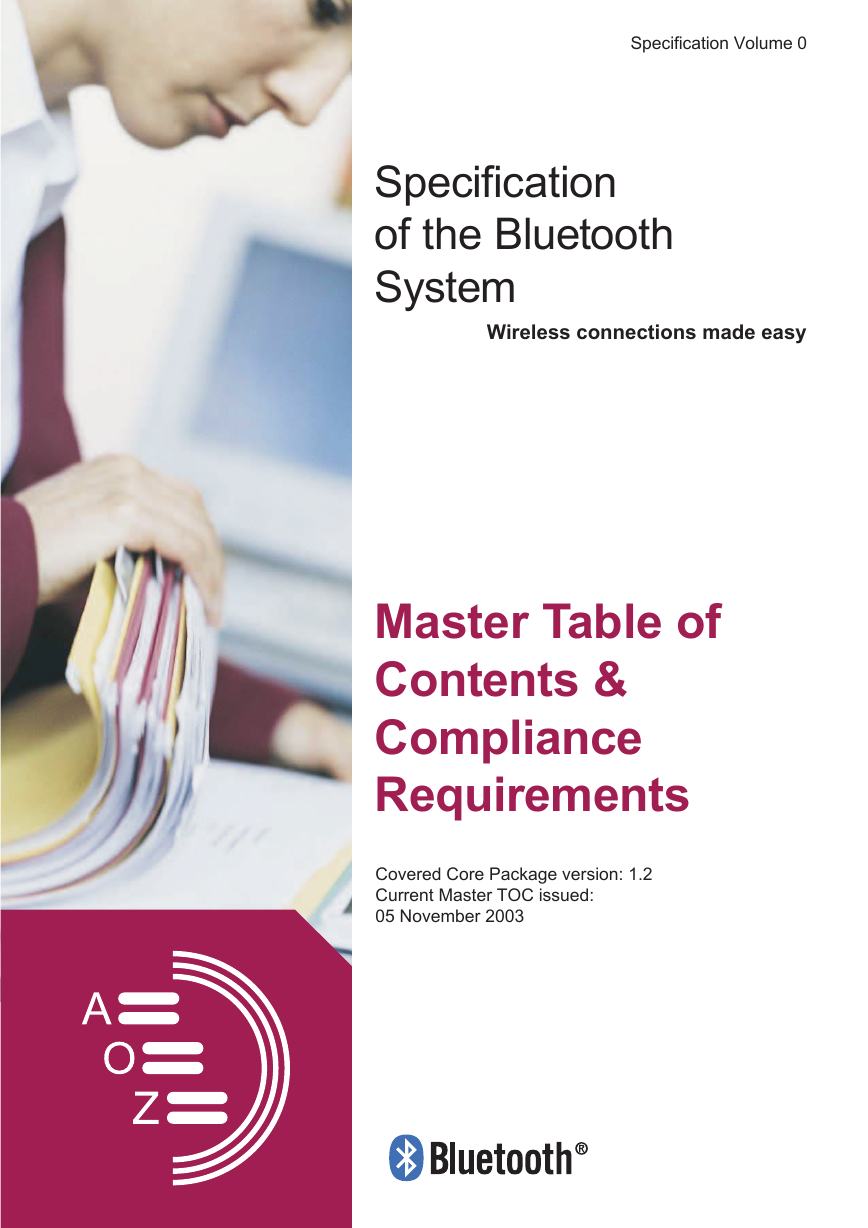
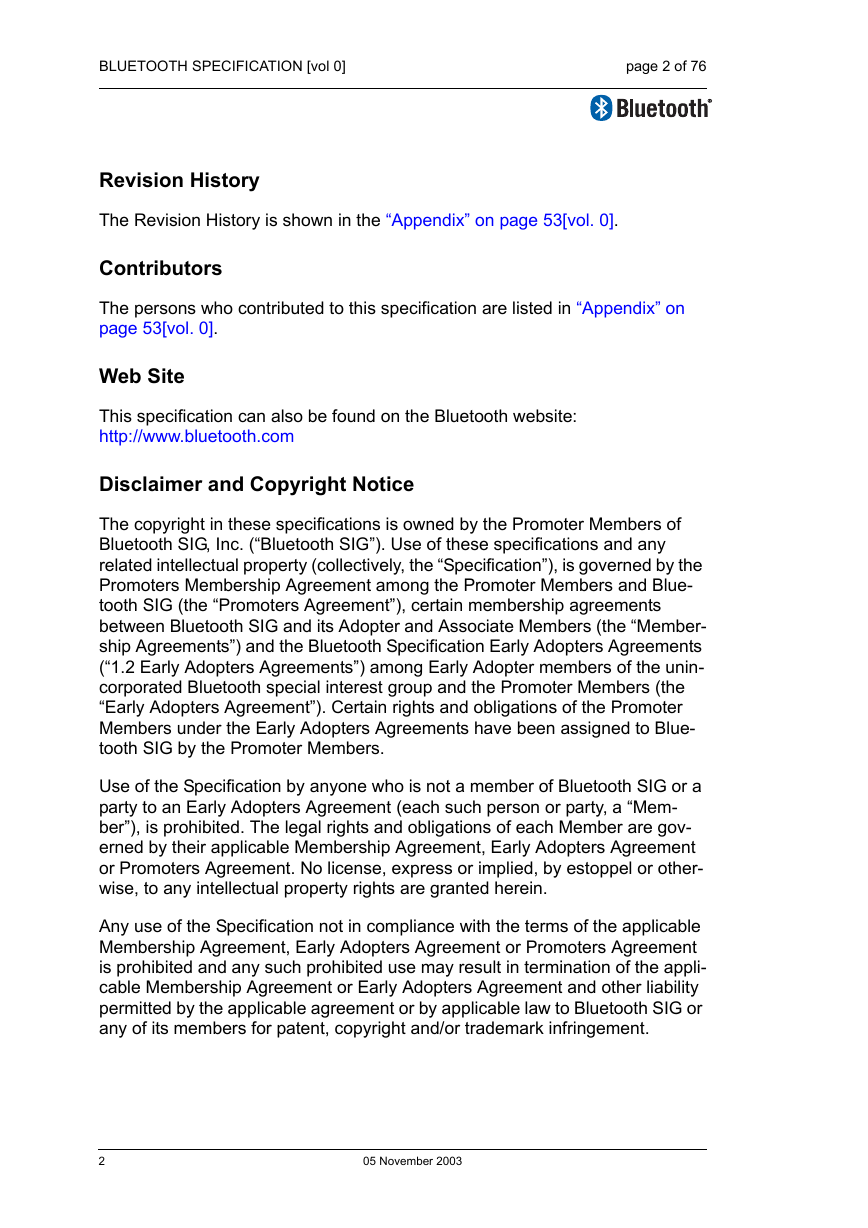
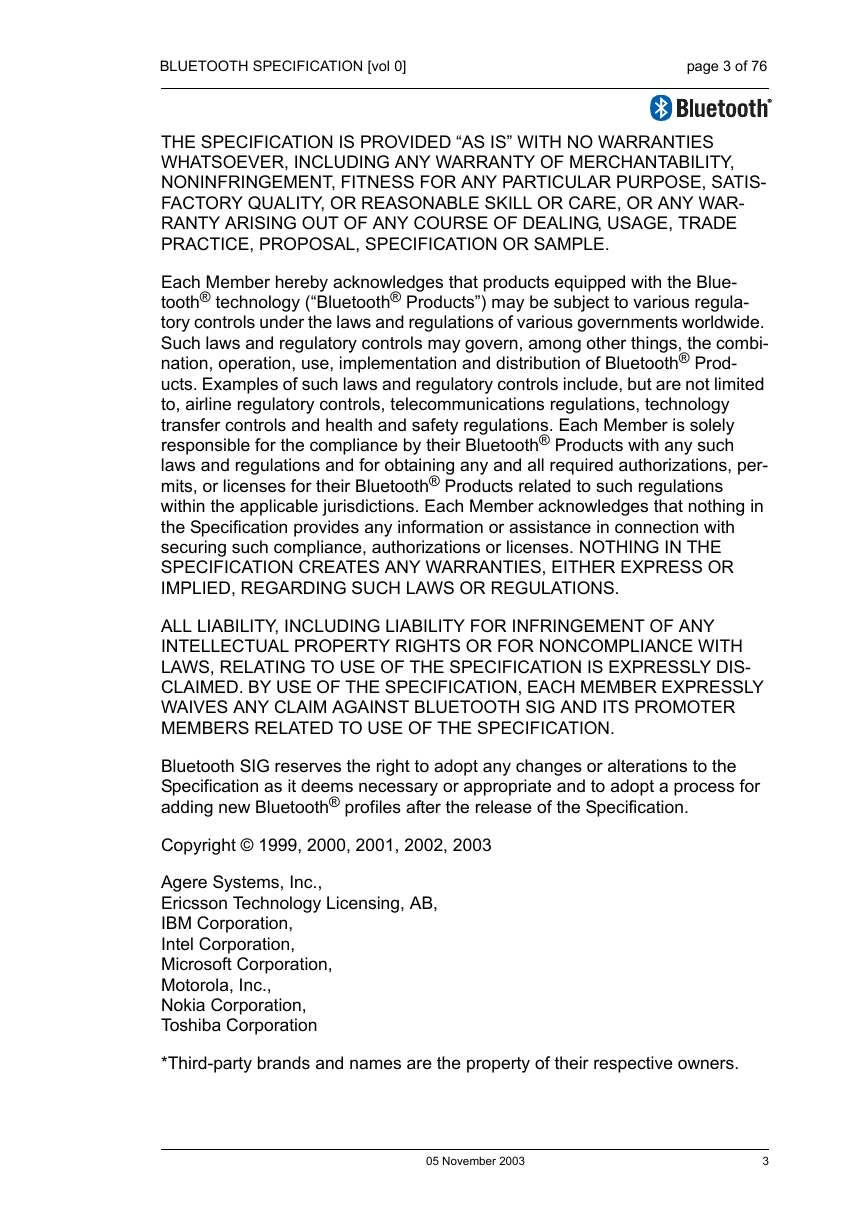
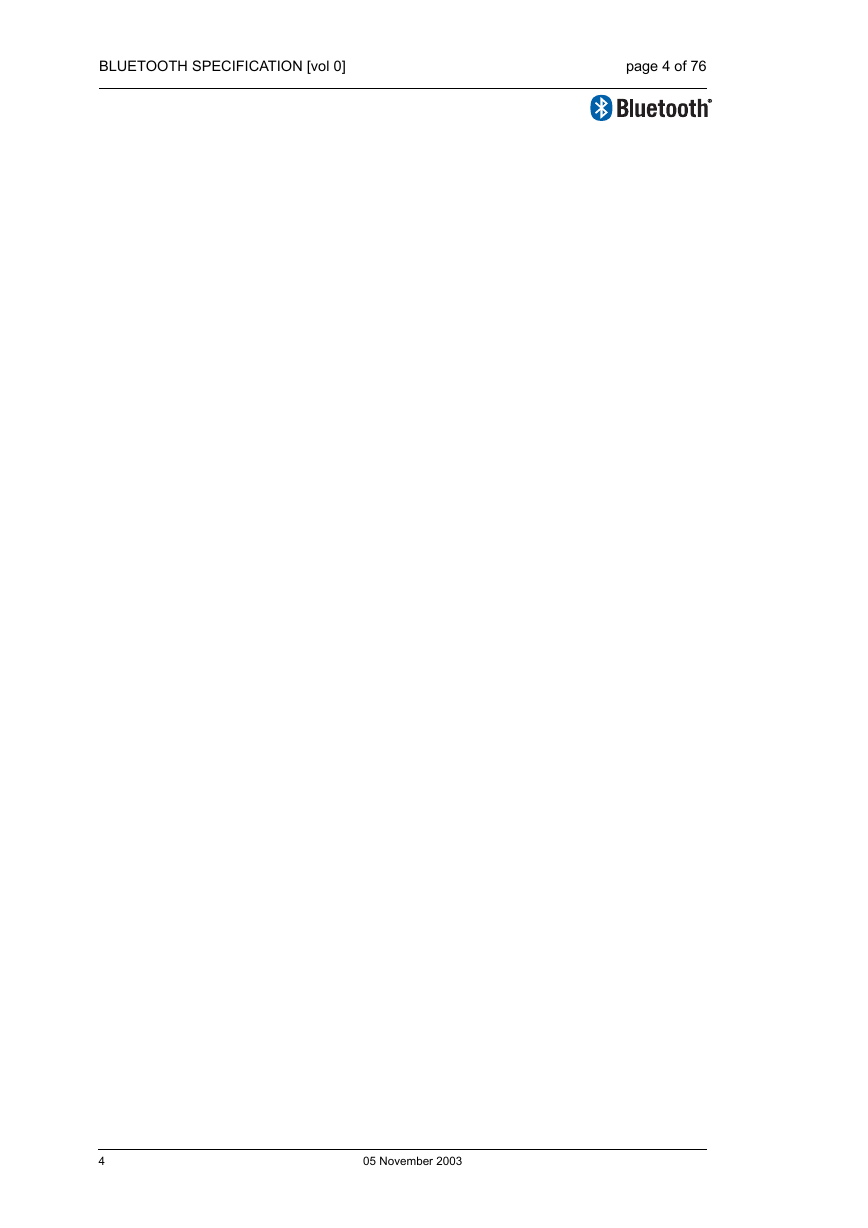
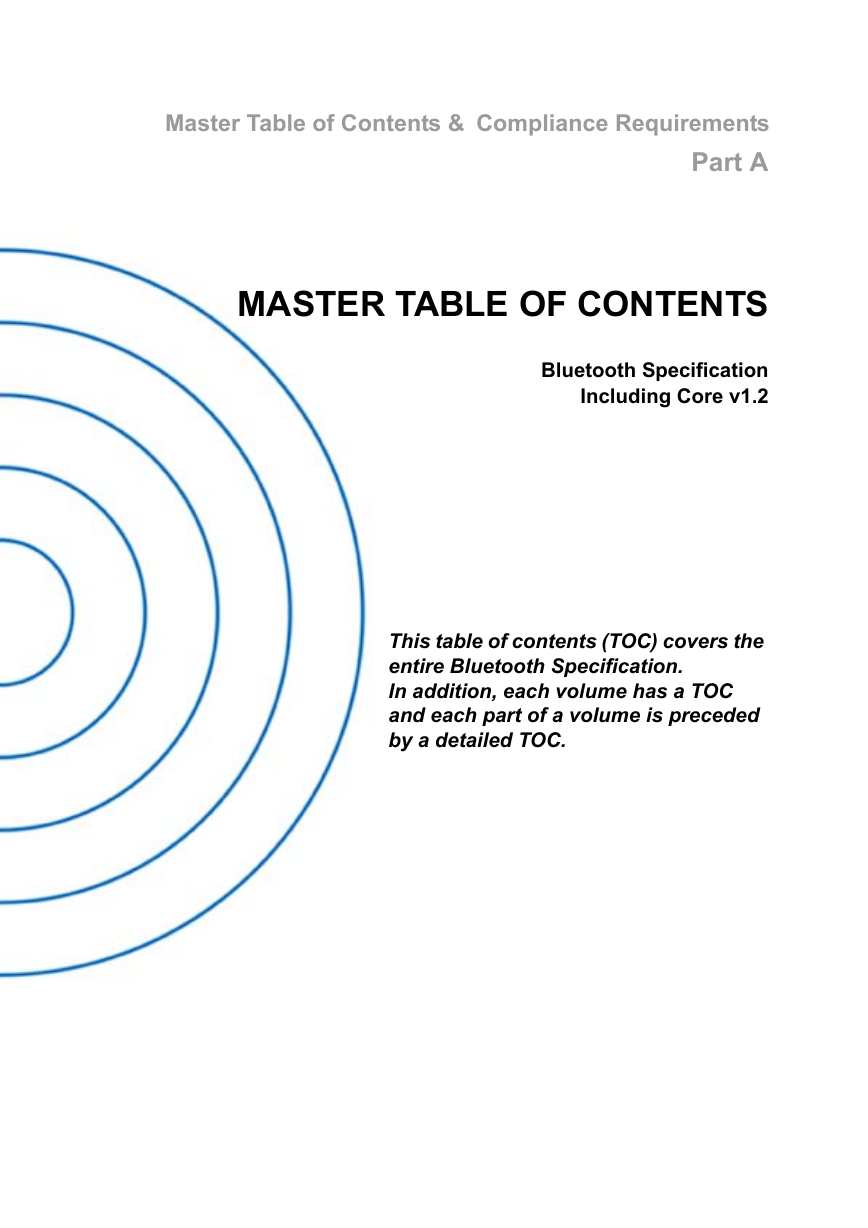
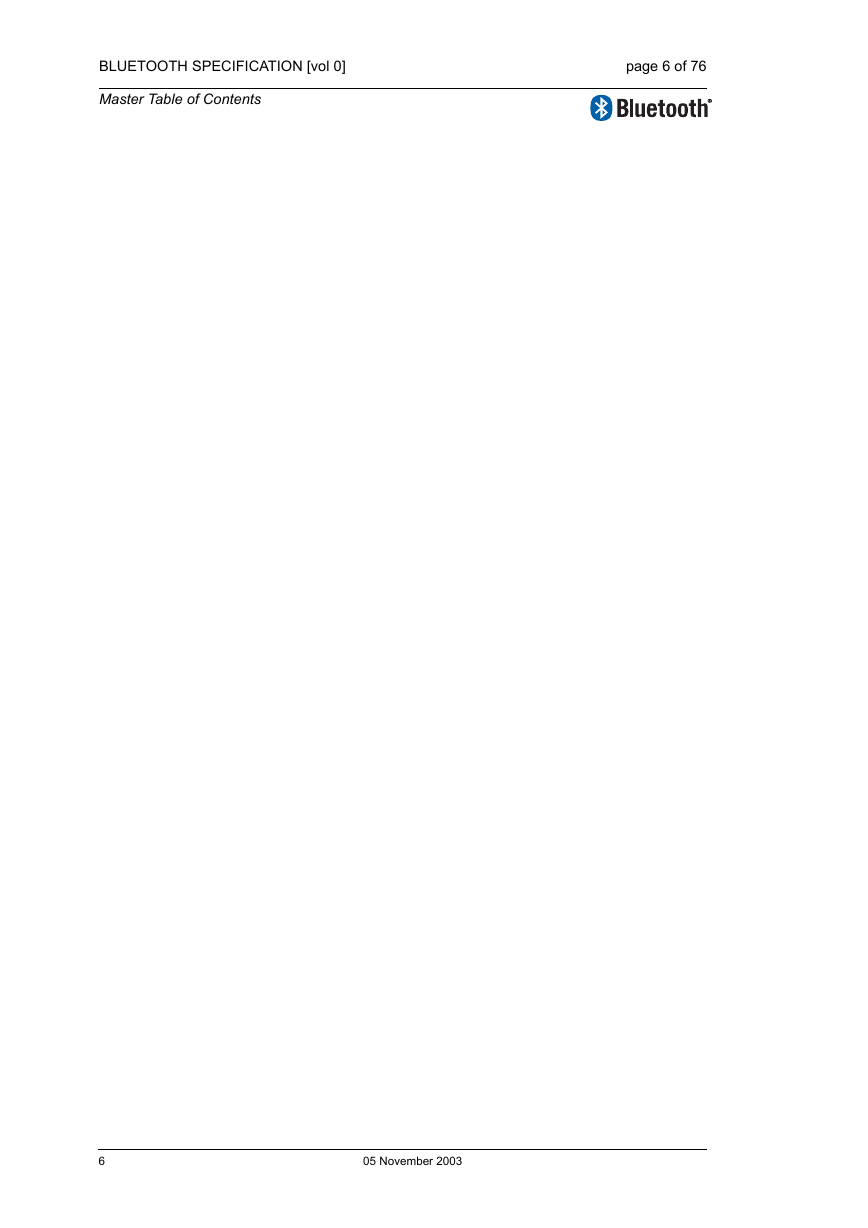
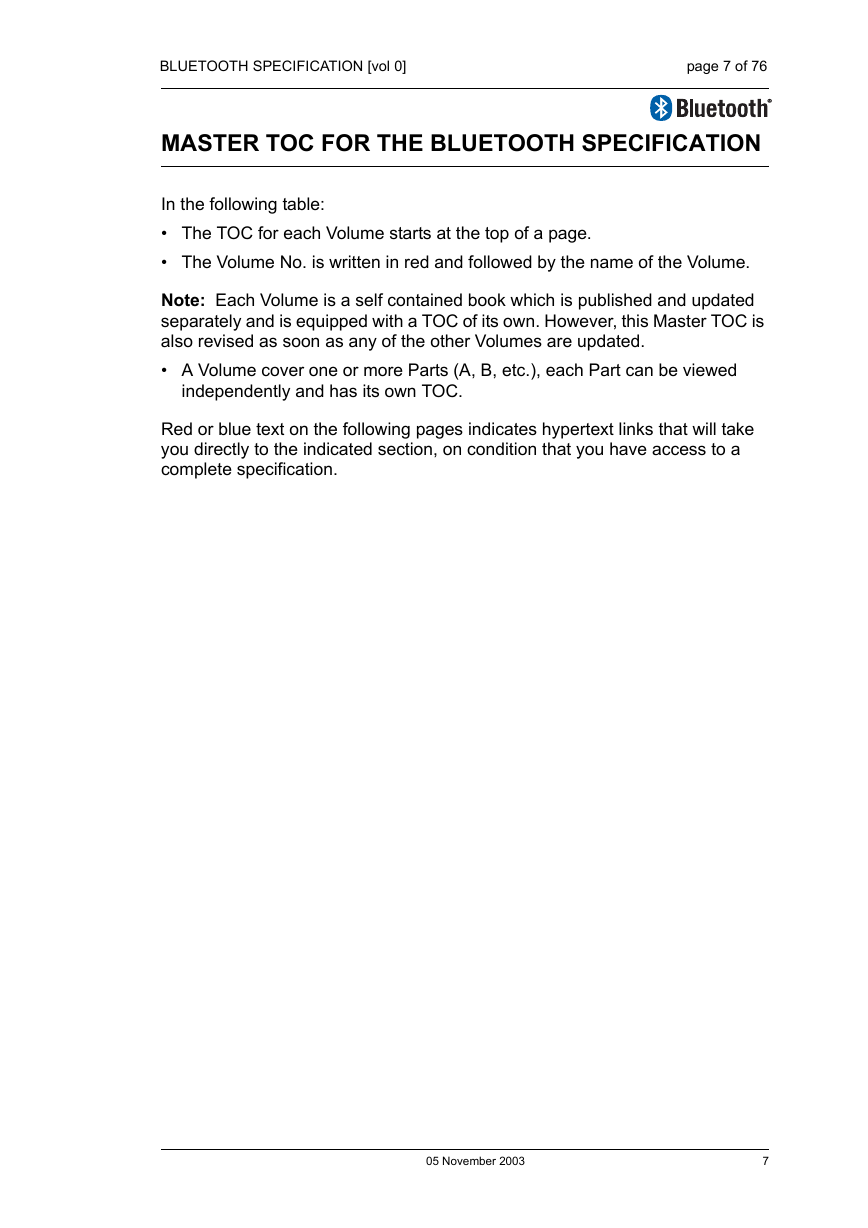
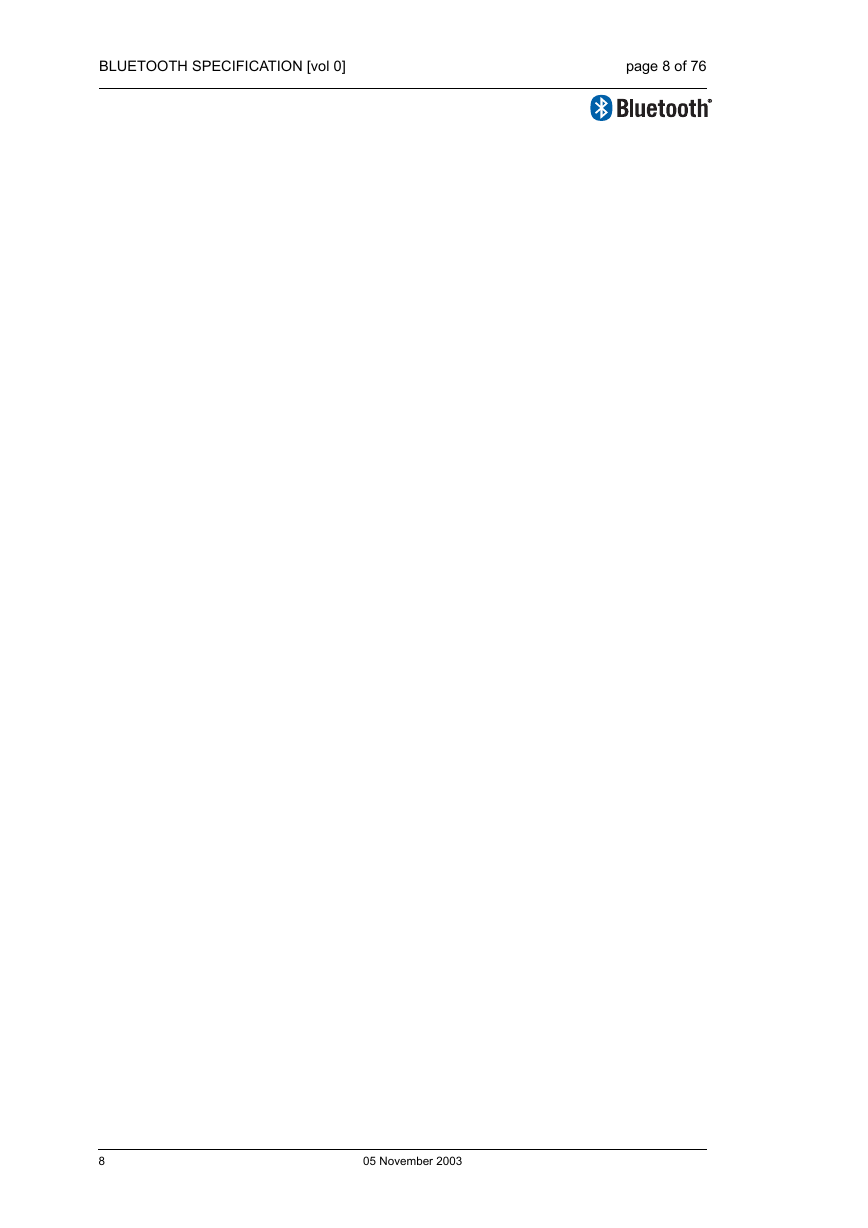








 2023年江西萍乡中考道德与法治真题及答案.doc
2023年江西萍乡中考道德与法治真题及答案.doc 2012年重庆南川中考生物真题及答案.doc
2012年重庆南川中考生物真题及答案.doc 2013年江西师范大学地理学综合及文艺理论基础考研真题.doc
2013年江西师范大学地理学综合及文艺理论基础考研真题.doc 2020年四川甘孜小升初语文真题及答案I卷.doc
2020年四川甘孜小升初语文真题及答案I卷.doc 2020年注册岩土工程师专业基础考试真题及答案.doc
2020年注册岩土工程师专业基础考试真题及答案.doc 2023-2024学年福建省厦门市九年级上学期数学月考试题及答案.doc
2023-2024学年福建省厦门市九年级上学期数学月考试题及答案.doc 2021-2022学年辽宁省沈阳市大东区九年级上学期语文期末试题及答案.doc
2021-2022学年辽宁省沈阳市大东区九年级上学期语文期末试题及答案.doc 2022-2023学年北京东城区初三第一学期物理期末试卷及答案.doc
2022-2023学年北京东城区初三第一学期物理期末试卷及答案.doc 2018上半年江西教师资格初中地理学科知识与教学能力真题及答案.doc
2018上半年江西教师资格初中地理学科知识与教学能力真题及答案.doc 2012年河北国家公务员申论考试真题及答案-省级.doc
2012年河北国家公务员申论考试真题及答案-省级.doc 2020-2021学年江苏省扬州市江都区邵樊片九年级上学期数学第一次质量检测试题及答案.doc
2020-2021学年江苏省扬州市江都区邵樊片九年级上学期数学第一次质量检测试题及答案.doc 2022下半年黑龙江教师资格证中学综合素质真题及答案.doc
2022下半年黑龙江教师资格证中学综合素质真题及答案.doc